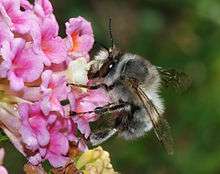Anthophorini
The Anthophorini are a large tribe in the subfamily Apinae of the family Apidae. Species in this tribe are often referred to as digger bees, although this common name is sometimes also applied to members of the tribe Centridini. It has over 750 species worldwide that were previously classified in the family Anthophoridae; the vast majority of species are in the genera Amegilla and Anthophora.
| Anthophorini | |
|---|---|
 | |
| Male Anthophora plumipes | |
| Scientific classification | |
| Kingdom: | Animalia |
| Phylum: | Arthropoda |
| Class: | Insecta |
| Order: | Hymenoptera |
| Family: | Apidae |
| Subfamily: | Apinae |
| Tribe: | Anthophorini |
| Genera | |
| |
Description
All Anthophorini species are solitary, though many nest in large aggregations. Nearly all species make nests in the soil, either in banks or in flat ground; the larvae develop in cells with waterproof linings and do not spin cocoons.
The characters used to define this group are subtle, but they are nonetheless fairly recognizable.
- They are generally large (up to 3 cm), very robust, hairy bees, with visibly protruding faces, and the apical portion of the wings are studded with microscopic papillae.
- The abdomen is often banded, and in many Old World species of Amegilla, these bands are metallic blue.
- The wings often appear disproportionately short compared to other bees.
- Their "buzz" is often a high-pitched whine, as they hover and feed on flowers.
- Males commonly have pale white or yellow facial markings, and/or peculiarly modified leg armature and hairs.
Genera
- Amegilla
- Anthophora
- Deltoptila
- Elaphropoda
- Habrophorula
- Habropoda
- Pachymelus
- †Protohabropoda[1]
gollark: > basic reading comprehension: surprisingly uncommonIndeed. People often just treat information related to computers or general technical stuff they don't know much about as utterly unfathomable, when it... isn't.
gollark: Servers generally ship in convenient rackable form factors, as do some network switches and stuff.
gollark: And other datacentre hardware.
gollark: Racks are just a standard way to mount lots of servers densely.
gollark: TL;DR there are very sophisticated automatic systems trying to take any available money.
References
- Dehon, M.; Michez, D.; Nel, A.; Engel, M. S.; De Meulemeester, T. (2014). "Wing Shape of Four New Bee Fossils (Hymenoptera: Anthophila) Provides Insights to Bee Evolution". PLOS ONE. 9 (10): 1–16. doi:10.1371/journal.pone.0108865. PMC 4212905. PMID 25354170.
- Michener, C. D. (2000). The Bees of the World. Baltimore: Johns Hopkins University Press. ISBN 9780801861338. OCLC 912147043.
External links
| Wikimedia Commons has media related to Anthophorini. |
| Wikispecies has information related to Anthophorini |
This article is issued from Wikipedia. The text is licensed under Creative Commons - Attribution - Sharealike. Additional terms may apply for the media files.